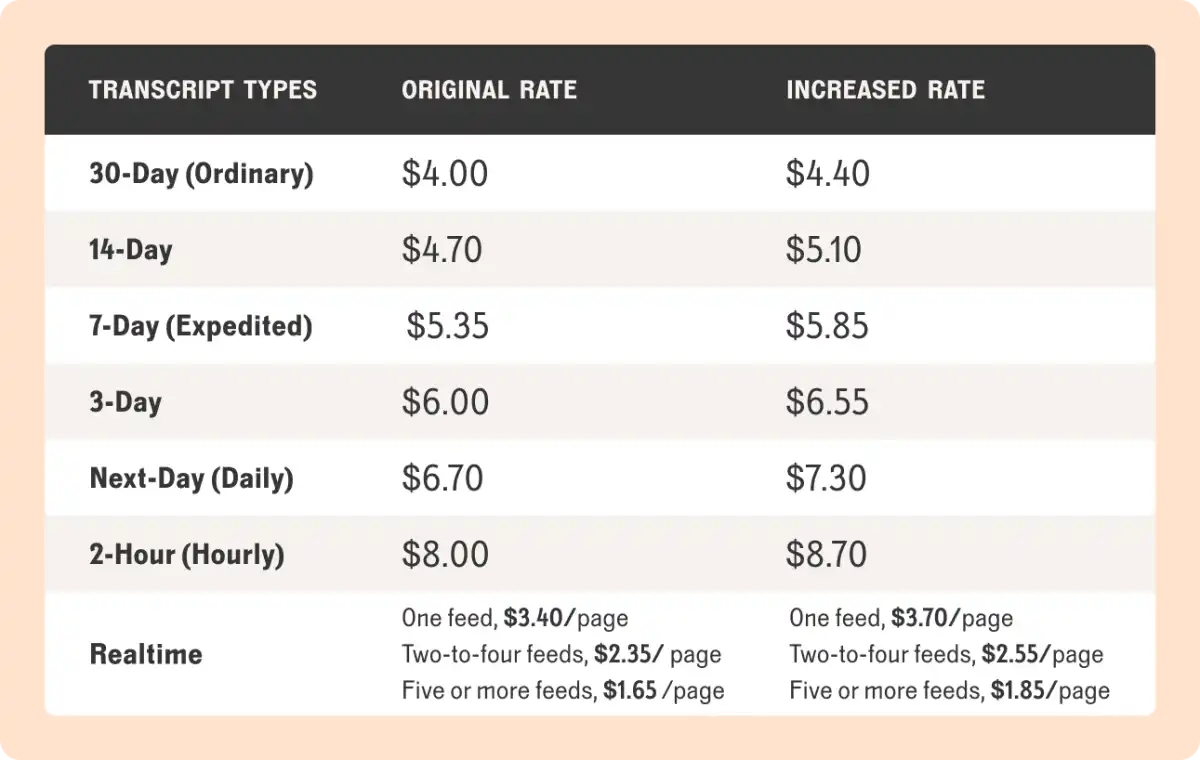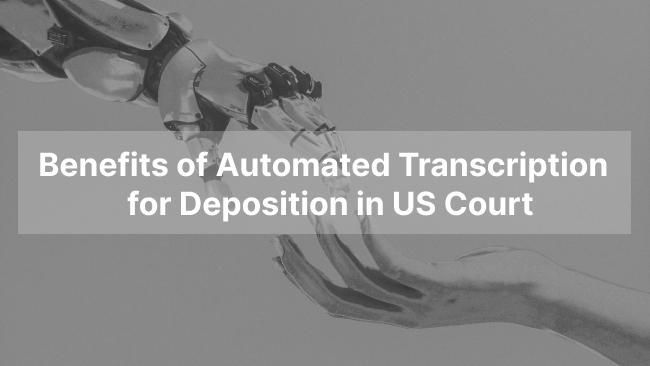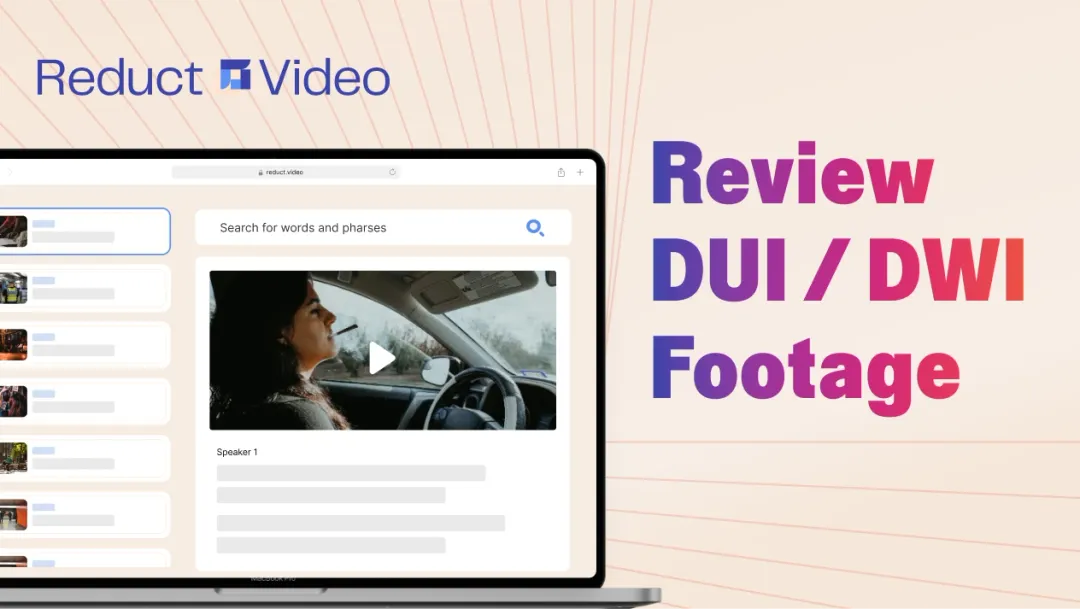The Role of Modern Transcripts in Navigating Large Volume of Discovery
December 2024
·
4 min read

Public defenders need to spend anywhere from 13.5 to 286 hours on a case, depending on whether it involves a less severe issue like a parole violation, or a high-severity felony case like murder.
But increasing amounts of discovery in modern public defense practice from cell phones, surveillance cameras and body-worn cameras take more time for each case than public defenders usually have.
With these multimedia-heavy cases, you probably only have the court reporters transcribe what you feel are the most relevant bits from the discovery because not only is the delivery time slow, the cost can quickly add up with the appearance fees, page rates and additional charges of court reporters.
Thanks to recent advancements in legaltech, there are plenty of tools built with our overworked public defenders in mind—legal transcription, evidence management, courtroom presentation, or an all-in-one tool that offers them all.
After closely working with public defenders for a long time, we at Reduct have found a tailored solution for your discovery and evidence management problems—modern transcripts!
What are modern transcripts?
Modern transcripts solve the challenges of court transcription, they are:
-
Affordable
-
Fast
-
Linked to the source
-
Searchable
-
Completely cloud-based
1. Affordable: AI transcripts at a fraction of the cost of the court transcripts
You likely have plenty of experience dealing with minor traffic stops that garner extensive footage from body cams, dash cams and cell phones.
Sending out the entirety of the discovery for court transcription would cost an arm and a leg considering the per page rates and additional charges of court reporters. On top of that, the Judicial Conference of the United States recently approved an increase to transcript fees effective October 1, 2024, so court transcripts are now more expensive than ever.

Modern transcripts, on the other hand, cost a small fraction of these court rates, so you can have all your discovery transcribed while staying within the allocated budget for the case.
At Reduct, you can get an initial AI draft of the transcripts for just $0.25 per minute. Plus, you do not get charged for long periods of silence where maybe an officer is simply monitoring a potential suspect with his body camera on but nothing happens at the moment, or the defendant is left alone in the room in the middle of an interrogation.
If you want error-free transcripts for parts of the discovery with key evidence, you also have the option to send it for a human review at an additional dollar per minute, which is still about 3.5x cheaper than court reporting.
2. Fast: Transcripts ready for review in the time it takes to brew a cup of coffee
The difference between sending out a 1-hour video and 10 hours of video discovery for court transcription and receiving the final transcript can be anywhere between days to weeks.
Since modern transcriptions are created by AI run on computers, they can divide the large chunks of audio into sections and distribute the workload between multiple servers.
This means that it takes the same amount of time for the transcription to come back no matter how many hours of video or audio recordings you have.
Not having to worry about the volume means that you can review the transcripts and prepare for the case without any delays.
3. Linked to the source: Time-synced transcripts so you can verify important evidence
Unlike court transcripts, which you typically receive as a physical document, modern transcripts include accompanying audio or video that you can listen to or watch alongside the text.
For instance, you skim over the transcript of a police brutality case and come across a section where the defendant is shouting for help because a police officer is using force. You would want to watch the footage in this instance for more context.
With court transcripts, you’d have to switch between paper and computer to verify it, making it super cumbersome to find that specific moment. When you work with modern transcripts though, you can click on the word and it’ll take you to that exact point in the video, so you can watch the specific clip right then and there.
4. Searchable: Search all your discovery to get to the key moments of the case quickly
Modern transcripts are incredibly handy for instances where you maybe remember hearing an important exchange in the footage but can’t exactly pinpoint where you heard it.
If you were doing it the standard way, what you would do is skim over the entire transcripts to find what you were looking for.
Now instead of doing that, and rewatching the entire footage to verify it, you have tools that let you search for the exact word or phrase with a click and they’ll find all instances in the transcript where it was used.
To make navigating discovery easier, we at Reduct created what we call a searchable repository, which makes it possible for you to search across a particular case folder or multiple folders at once. In addition to exact matches of the search terms, you also get close matches so you don’t miss any crucial evidence.
Elizabeth D. Cadiz, the Deputy Chief Public Defender in Aurora, Colorado, shared her experience using Reduct where in one of her cases, her primary argument was centered around racial discrimination against her African-American client.
Using Reduct’s search features, she was able to find a particular phrase used by a witness which was racially inflammatory. This ended up becoming a key piece of evidence in the case centered around race, and her client was found not guilty.
5. Completely cloud-based: Collaborate with your investigators, co-counsel and paralegals in real time
One of the standout features of modern transcripts is their completely cloud-based nature.
While the standard methods typically require physical documents to be passed around, modern transcription platforms let you and your co-counsel access and work on the same transcripts simultaneously from anywhere.
This means you can highlight crucial evidence, leave comments for each other on the important bits, and extract video exhibits that everyone can access.
If you’re more of a pen-and-paper kind of person, you can still print the transcripts so you have a physical copy on hand.
The demands of modern public defense practice require innovative solutions to manage the increasing volume of discovery materials. Standard methods can be time-consuming and costly, making it challenging for you to effectively prepare your cases.
Modern transcripts offer a transformative alternative that is affordable, fast, collaborative and linked to the source of truth. With features like real-time access to multimedia evidence, searchable repositories for quick reference, and cloud-based collaboration, you can spend less time on irrelevant discovery and more time on the actual evidence in the case.
Try Reduct today to experience the benefits of modern transcripts or contact our sales team for more information on how we can support your legal practice.


